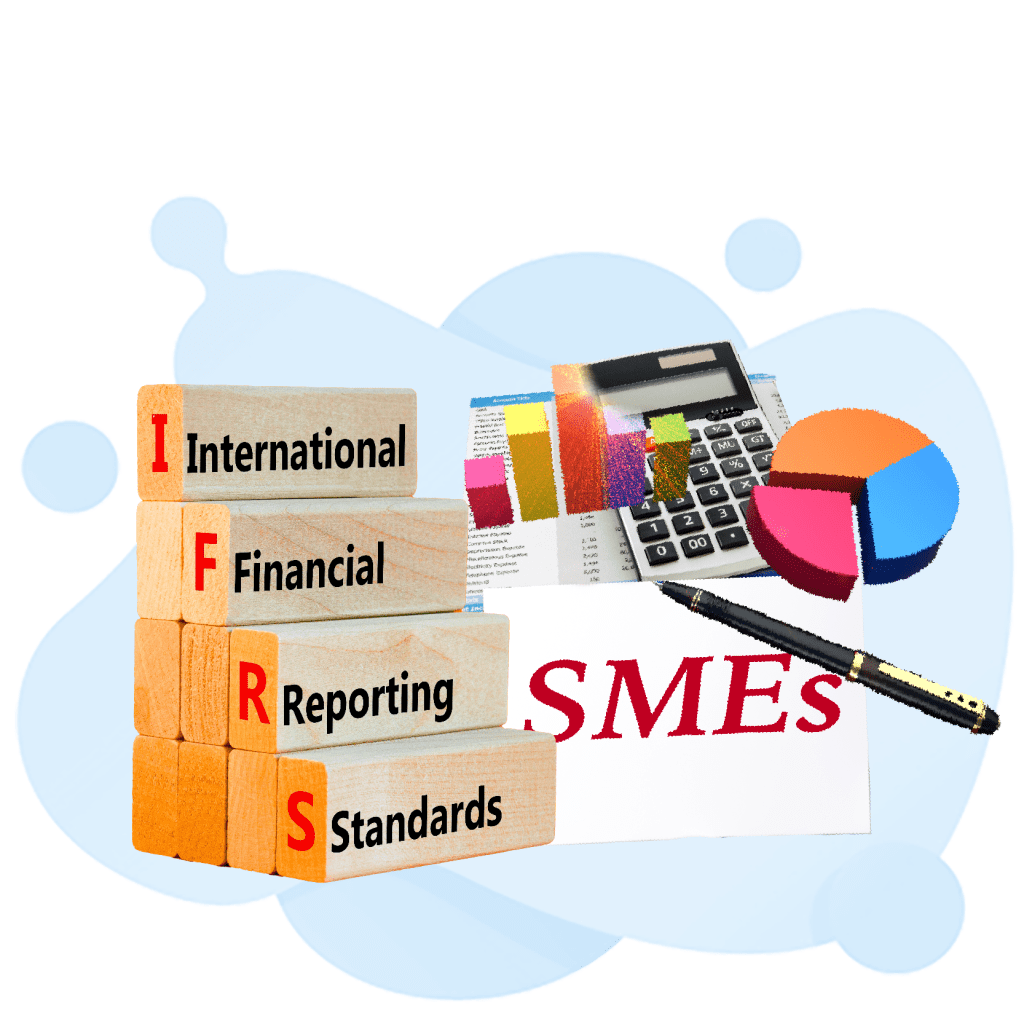Advantages of IFRS for SMEs

IFRS for SMEs is an accounting standard for small and medium-sized entities. It aims to simplify the rules for reporting financial statements. It also aims to make those rules more relevant for users of SMEs’ financial statements.
Rudzani & Charles (2016) found that SMEs need help acquiring resources, especially technology, which inhibits their adoption of IFRS for SMEs. Consequently, a good accountant is necessary.
IFRS for SMEs
The IFRS for SMEs Standard reduces disclosure requirements and simplifies accounting rules, especially in relation to intangible assets, financial instruments and goodwill. The IFRS for SMEs Standard is also designed to be more cost-effective than full IFRS. Moreover, the IFRS for SMEs is less complex than full IFRS, which requires more than 2,500 pages of framework pages.
The decision on whether an entity should use IFRS for SMEs remains with the national regulatory authorities and standard-setters, which usually set more detailed eligibility criteria. This may include, for example, turnover tests or a statement of financial position.
IFRS for SMEs is primarily geared toward private company reporting, and thus, many private companies qualify to apply it. However, private companies must comply with the IFRS for SMEs standard in its entirety — they cannot cherry pick from its requirements. A supplemental resource on this subject is being developed by the AICPA Accounting Standards team. It will compare IFRS for SMEs to US GAAP. The AICPA is seeking input from its members on the comparison.
IFRS 16 for SMEs
IFRS for SMEs is an international accounting standard designed for private companies. Its purpose is to create a common framework for financial reporting by private companies, which will enable them to compete more easily in the global economy. The standard is intended to reduce costs for preparers and users by reducing the need for specialized knowledge and by increasing comparability of financial statements. It is also intended to promote a more principle-based approach to financial reporting.
In its recent comprehensive review of the IFRS for SMEs Standard, the IASB considered two options for aligning the IFRS for SMEs Standard with new and amended full IFRS Standards. In its analysis, the Board focused on three principles of alignment—relevance, simplicity and faithful representation—as it considered the appropriateness of each of these potential amendments.
One proposal considered the benefit of requiring recognition of lease liabilities for all leased assets, as opposed to the previous requirement that only financed equipment be recognised on the balance sheet. The change would eliminate off-balance-sheet financing and make it easier for users to assess the financial health of an organisation by identifying future cash outflows from leasing arrangements.

IFRS for SMEs Illustrative Financial Statements
The IFRS for SMEs standard contains exemptions from some of the more onerous reporting requirements that would otherwise be applied by listed companies complying with full IFRS Standards. These changes are aimed at reducing costs and burdens on SMEs while allowing them to transition easily to full IFRS Standards if they decide to become publicly listed. In addition, the IFRS for SMEs standard makes a number of improvements to accounting for business combinations including requiring contingent consideration to be measured at fair value and improving consistency in how SMEs account for step-acquisitions.
The IASB intends IFRS for SMEs to be used by entities that meet the definition of a “small and medium-sized enterprise” and publish general purpose financial statements for external users without public accountability. In practice, this includes many private entities in the United States.
While significant hurdles remain, the AICPA supports the issuance of IFRS for SMEs and believes that private entities should be allowed to choose the reporting framework that best fits their objectives and the needs of their financial statement users. To this end, the AICPA governing Council has approved amendments to its rules that give members the option of using IFRS for SMEs as an alternative to US GAAP.
IFRS for SMEs PDF
The IFRS for SMEs Standard provides a self-contained set of international accounting standards that is simpler than full IFRS Standards. Its use should increase confidence in financial statements of SMEs and reduce the significant costs involved in maintaining IFRS Standards on a national basis. The IFRS for SMEs Standard contains a number of exemptions from the disclosure requirements in full IFRS Standards, such as frequency of reporting and the need for comparative information. These exemptions are designed to ensure that the IFRS for SMEs Standard does not result in a two-tier system of reporting for SMEs.

Private companies can choose whether to report in accordance with IFRS for SMEs or the United States GAAP. However, IFRS for SMEs may present additional challenges in the preparation of financial statements that are compliant with the IFRS for SMEs Standard. The AICPA Accounting Standards team encourages IFRS for SMEs users and preparers to keep abreast of the latest developments in the IFRS for SMEs Standard. A comparison resource will be available as the work is completed, and the Accounting Standards team welcomes input from members of the accounting profession and others with expertise in IFRS for SMEs and US GAAP.
Full IFRS vs IFRS for SMEs
IFRS for SMEs provides less complex and more cost-effective accounting and reporting requirements. This standard eliminates certain costs and burdens associated with complying with full IFRS, including the expense of preparing a consolidated financial statement. It also requires the use of the historical cost model, which allows for greater consistency in the treatment of transactions and events. It also applies a single definition of amortization, thereby eliminating the need to prepare depreciation tables and schedules. It also includes an option for the recognition of interest directly attributable to the acquisition, construction or production of assets and requires that a business combination be accounted for using the purchase method, which reduces transaction costs by treating all consideration as cash and excludes contingent consideration where it is probable that it will be paid.
There are many factors that influence whether a country adopts IFRS for SMEs. These include education level, the quality of national financial accounting standards and the relationship between accounting and tax. Interestingly, we do not find any evidence that foreign aid has an impact on the decision to adopt IFRS for SMEs.

IFRS for SMEs Disclosure Checklist
The IFRS for SMEs standard is designed to be used by entities that do not have public accountability and publish general purpose financial statements for external users. It is for standard setters and regulatory bodies to determine which entities can use this framework, and a number of factors may influence that decision. These include the types and needs of users of a company’s financial statements and possible regulatory reporting requirements.
In order to achieve this objective, the IASB has eased recognition and measurement requirements, simplified disclosures and omitted topics not relevant to SMEs. It has also shortened the revision cycle to three years, making the IFRS for SMEs more usable and cost-effective.
The IASB is developing a reduced disclosure IFRS standard that would be applied on a voluntary basis by subsidiaries of companies using the IFRS for SMEs standard, in addition to full IFRS standards. This new standard will allow those subsidiaries to apply the recognition and measurement requirements of the IFRS for SMEs standard while preparing their financial statements in accordance with the full IFRS standard.
IFRS for SMEs Leases
IFRS for SMEs is an accounting framework developed by the IASB that is designed to meet the reporting needs of small and medium-sized entities. It is a set of financial reporting standards that is comparable to full IFRS and can be used by publicly accountable entities in all jurisdictions. It is also recognised as a generally accepted accounting standard.

Unlike full IFRS, IFRS for SMEs does not require the preparation of combined financial statements. However, if combined financial statements are prepared, they must be described as being in accordance with IFRS for SMEs. IFRS for SMEs requires disclosure of comparative information, significant accounting policies, and other relevant details about items presented in the primary financial statements.
IFRS for SMEs requires the recognition of lease assets and lease liabilities, but does not require them to be classified as either finance or operating leases. It also allows an entity to choose whether to recognise a remeasurement gain or loss in other comprehensive income rather than in profit or loss. It also requires the use of a cost model for accounting for financial assets and liabilities, and makes greater use of the underlying economics of assets and liabilities.
IFRS for SMEs Standard
A private company in the United States can use IFRS for SMEs if it meets certain requirements. These include publishing general purpose financial statements for external users and having no public accountability. However, many factors may influence whether a private company chooses to apply IFRS for SMEs or another framework commonly agreed at the EU level.
A modified version of full IFRS Standards, IFRS for SMEs is based on recognised concepts and pervasive principles. It also allows easier transition to full IFRS Standards if the company decides to become publicly listed. Its reporting requirements are shortened and its language is simplified, making them easier to understand. Disclosures are reduced for IFRS for SMEs in order to reduce the cost burden of applying the standard.
In addition to simplifying the accounting for leases, IFRS for SMEs clarifies that it is appropriate to recognise deferred tax assets and liabilities in the same amount as current taxes payable on those amounts and to record a single balancing entry in the profit and loss account when those amounts are recognised. It also introduces a new method for measuring the fair value of an asset or liability, using the spot rate at the time the asset or liability is initially recorded.